Artists
Artist Mina Alikhani’s ‘Confrontational’ Works Address the Unseen Realities of Life in Iran
The exhibit follows a previous show in response to the death of Mahsa Amini and the Women Life Freedom movement.
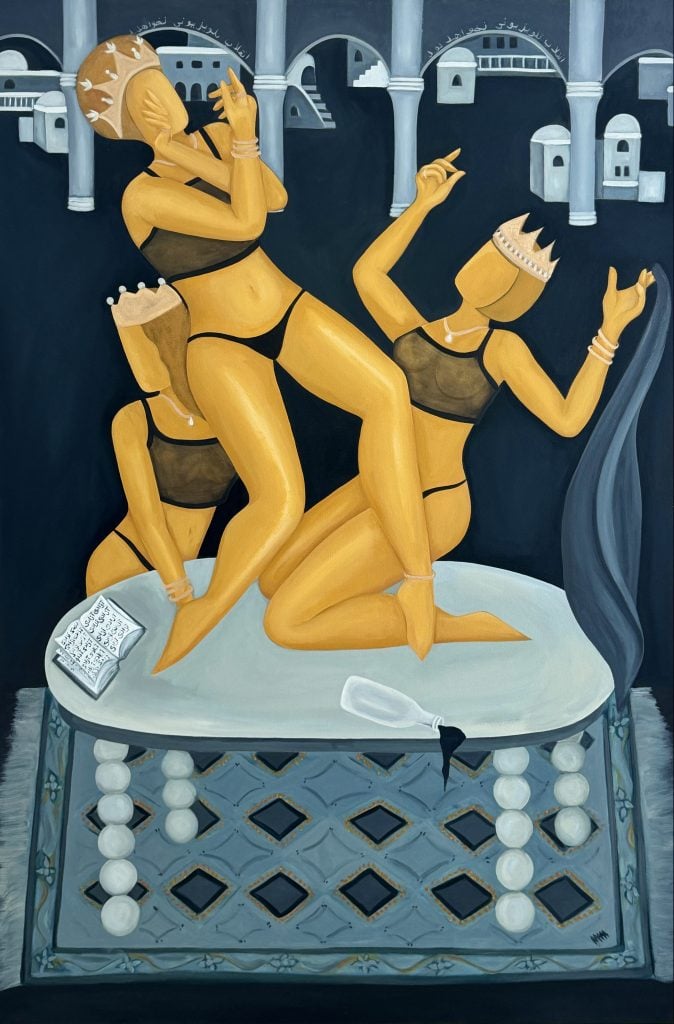
The exhibit follows a previous show in response to the death of Mahsa Amini and the Women Life Freedom movement.

Adam Schrader

Mina Alikhani does not shy away from politics in her work. The Iranian-American artist’s third solo exhibition, “Crimes Against God,” currently on view at Rebecca Moyalem Gallery in Los Angeles, takes aim at the theocratic rule in Iran under the Islamic Republic—a timely show that comes as U.S. political tensions rise with Iran amid the Israel-Gaza war.
Alikhani was born to Iranian parents who emigrated to the United States after the first supreme leader of Iran, Ayatollah Ruhollah Khomeini, seized power in 1979. Both her mother and father worked for Iran’s last monarch, the Shah of Iran, Mohammad Reza Pahlavi. Raised in a traditional Iranian household, the self-taught artist previously noted that she was raised by a “single hard-working mother and a deadbeat, drug addict father” in an interview with Art Squat. Within this home environment, drawing became one of her primary outlets of expression. Often surrounded by aunts, uncles, and cousins, she says her own personal memories and family dynamics have indelibly shaped her practice, in which the personal has always felt political.
Alikhani debuted on the art scene with her Los Angeles show “Defiance” on the same day in September 2022 that Iran’s morality police in Tehran killed the 22-year-old woman Mahsa Amini. Those headlines have further influenced the path of her career. Later that year, Alikhani showed a series of works in Miami at the Gibson Showroom titled “Revolution,” reflecting on topics of human rights pertaining to Iran.
Her current show builds on that series and, though it is not a direct response to the Israel-Gaza war, the works on view offer insight into the current state of the Middle Eastern political landscape, according to the artist.
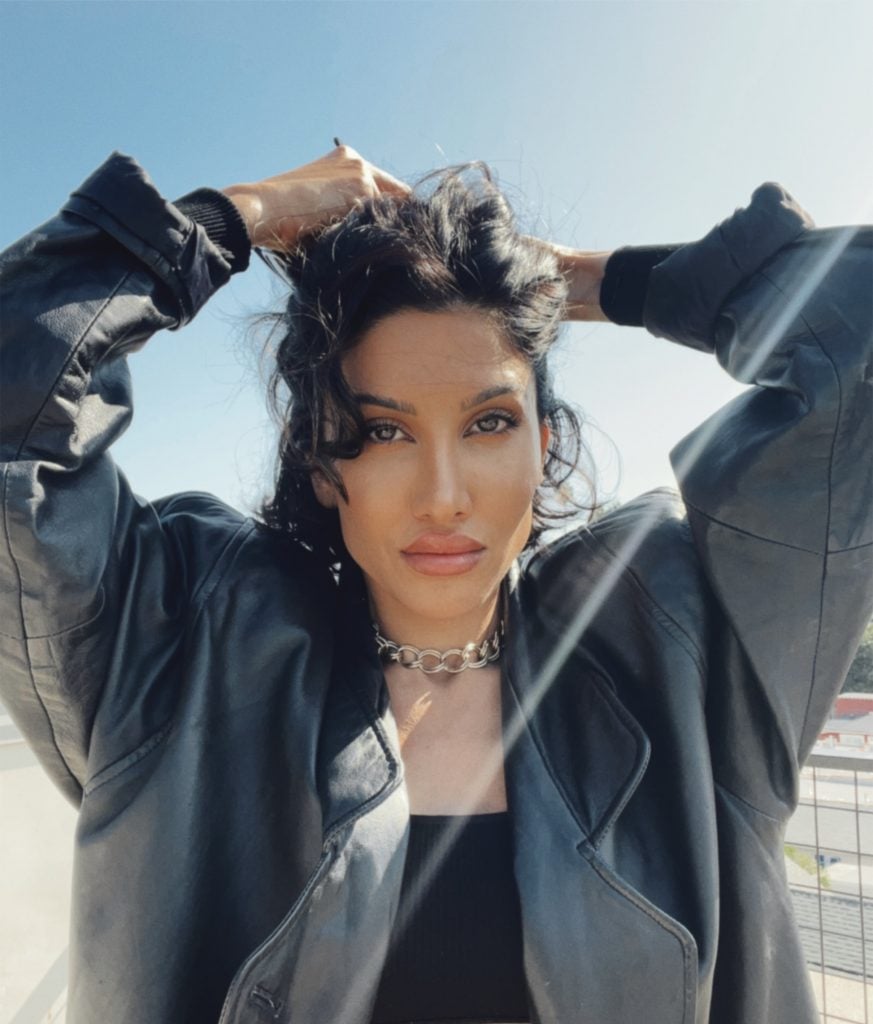
Mina Alikhani. Photo courtesy of Mina Alikhani
How did this show come to be? When did you start planning for it?
“Revolution” came off the heels of the Women Life Freedom movement, which was sparked by the murder of Mahsa Amini in Iran for improper wearing of the hijab. It was an uprising where women decided to forego headscarves and attire forced on them by the theocracy. For the first time since 1979, women were fighting back. They had enough.
It just so happened that the day of my first-ever exhibition—which had nothing to do with any humanitarian issues—coincided with that movement sparking. I went right back into the studio, kept my head down and worked for three months. I came out of that with “Revolution.”
It was important to portray what was going on. The work was slightly confrontational. People are trepidatious to expose what’s happening there because the regime is dangerous. There is a lot of blow-back you can get. I put the work out and people’s minds were blown that, under Sharia law, women basically had no rights in Iran and artists had no rights to express themselves and journalists were being held as political prisoners.
That work, “Revolution,” was a more literal and reactionary, and it was my anger, angst, and expression. I found it was effective in some ways. But taking a step back and learning from that body of work, I realized how much propaganda has done a job on Western culture with regards to matters of the Middle East.
So, I felt compelled to create a body of work that felt more educational by way of inviting curiosity, by presenting facts, by portraying things in our everyday life that may be perceived as normal freedom, like free the freedom to dance or sing, or identify as LGBTQ. I wanted to show how illegal those freedoms here are in Iran. Under a Sharia law called Moharebeh, the direct translation of that is ‘crimes against God,’ the Islamic Republic deems all those things as punishable by death in Iran.
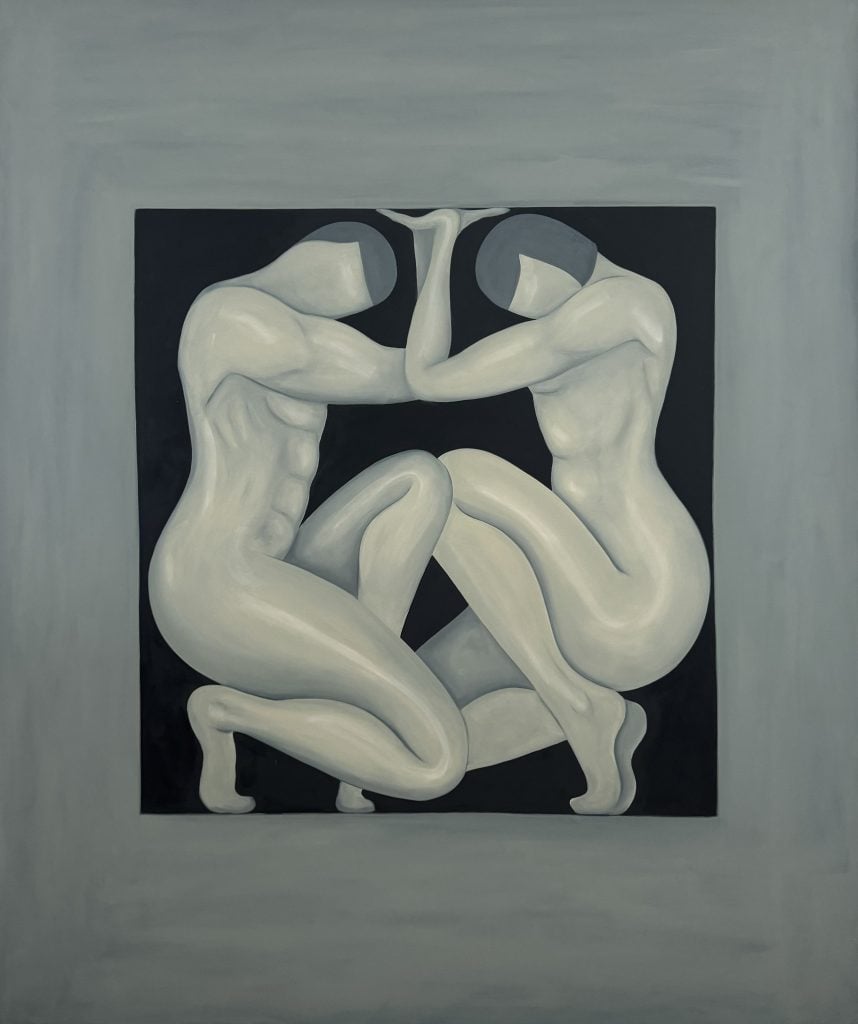
Mina Alikhani. Inherently Different, Beautifully Equal. Photo courtesy of Mina Alikhani
How does your new show visually compare with your past work? Are you doing anything different?
In the last exhibition, I did everything on Arches paper, which really flattens and deadens things in a beautiful way. I went into like full psycho mode. I lined the warehouse walls with a couple of rolls of paper and painted and painted and painted. This series has more works on canvas and there’s sculpture involved for the first time. I’m going to be exploring that medium a lot further and on a grander scale.
But I wanted the show to be more inviting, too. I used more color, and some of the shapes are a bit more three-dimensional. I wanted things to feel like they had life and flesh in them. And I’m sharing my sketches in this series, which I don’t typically do, I’m sharing some of the stream of consciousness that led to some of these pieces.
You’ve said that you draw a lot from your own family and upbringing when it comes to your work. How has your upbringing influenced your practice? What does your creative process look like now?
I was raised in America. But let me tell you how the household looked. We had eight people in the house. It was grandma, grandpa, uncles, aunts, and then the kids would be coming in. We had 12 people living at the house at any point, fresh off the boat from Iran. The house didn’t look like your traditional American house. So, I draw a lot from memory. But I do a lot of research at night before bed. When I’m done working, I’ll sit down and I will read and read and read, and I’ll save imagery, and I’ll take notes, and I’ll really process it, and then I get up in the morning, and I just work again.
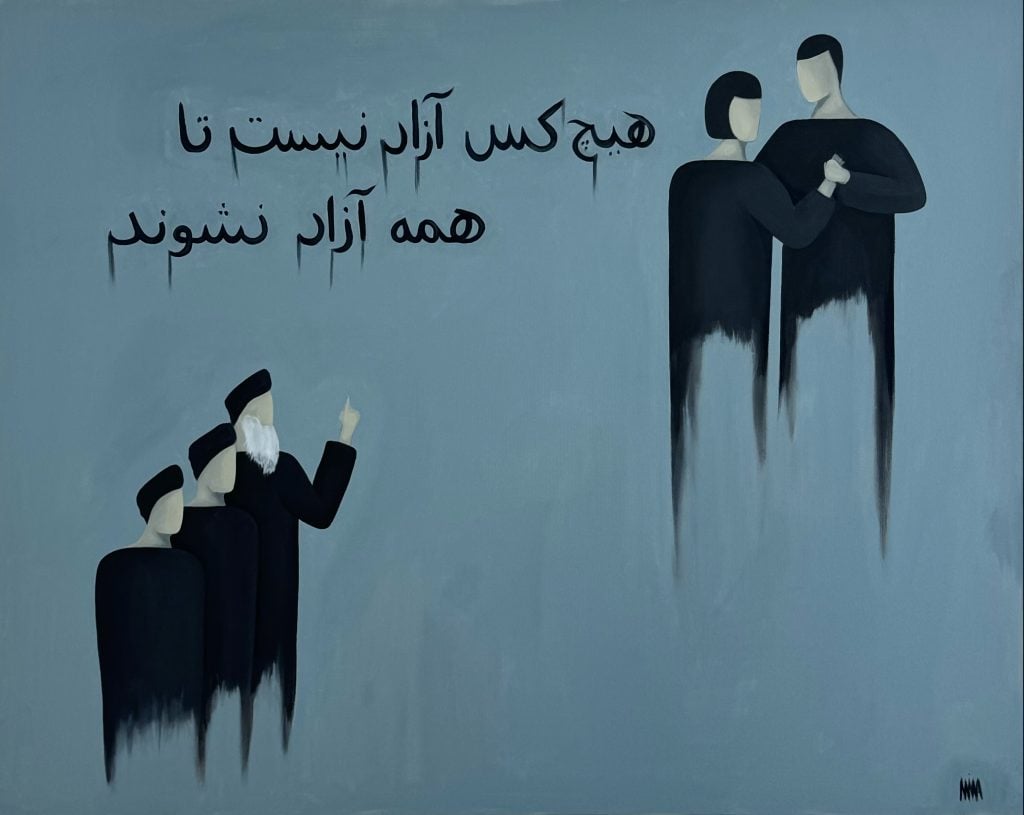
Mina Alikhani, No One Is Free Until We Are All Free. Photo courtesy of Mina Alikhani
Your parents grew up in Iran and have witnessed the political shifts within the country since then. Have they expressed any opinions about the political aspects of your work?
My mother left in 1979 when Ayatollah Khomeini took over and wiped out all their rights. She personally has been quite supportive. At first, she was a little concerned for my safety. I did get quite a few death threats from Sharia Law supporters all around the world. So, she was concerned for me, but she’s very supportive.
My father disowned me for my creative endeavors over 10 years ago. So that’s not really even been a conversation. But he’s troubled, anyway, and I think that the Islamic Republic has a way of brainwashing lost souls.
What has the response been in Iran to your work?
People want me to die for my work. I’ll either get statements like, ‘May Allah grant us the gift of cutting your head off,’ or they say, ‘Thank you so much. You give me hope in the dark.’ It’s never really like, ‘Hey, cool art.’ I’m okay with that because the best art makes you love it or hate it. I’m not out here ‘Live, Laugh, Love’-ing like a Home Goods sign.
Are you taking cues from Iranian art, historical or current? Are there other artists that you take inspiration from?
I have drawn a lot of inspiration from Iranian architecture, colloquial folk traditions, and the attire. I don’t have any particular artists that I draw inspiration from. But the culture of Iran has so many specific things to be inspired by: carpet-weaving patterns and customary tablecloths that are used for certain occasions, handwoven silk, and beautiful architecture like the Freedom Tower in Tehran, which is pictured in one of my prominent pieces in this series. I try to use a lot of traditional color palettes that are used in these national landmarks and on traditional Iranian clothing and all that stuff.
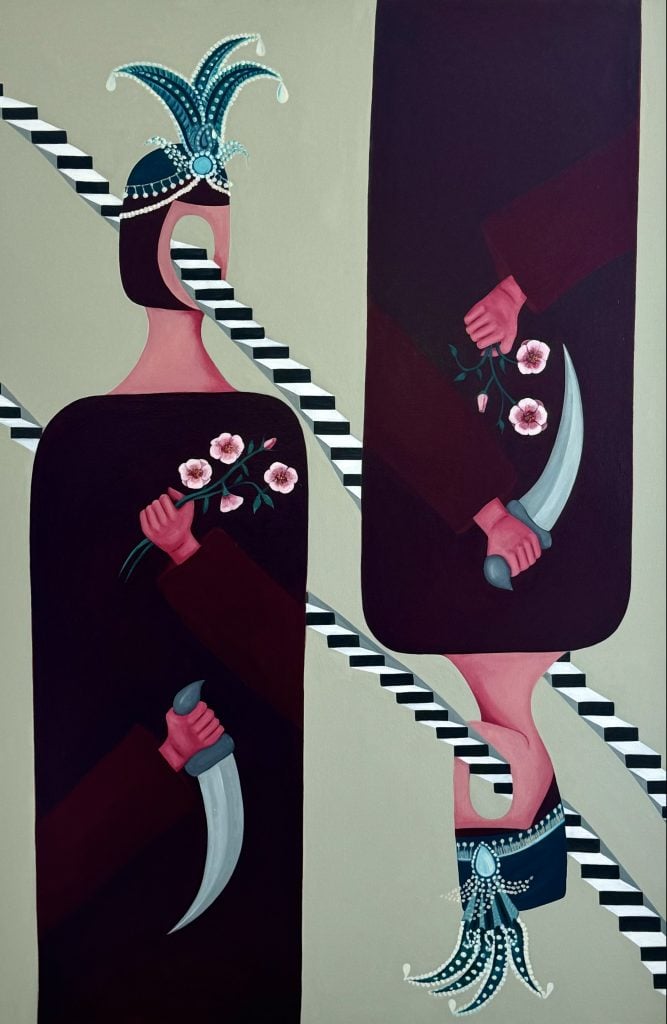
Mina Alikhani. Pleasure & War. Photo courtesy of Mina Alikhani
Given these traditional Iranian references, are there any sensitives that you have to consider when depicting traditional Muslim imagery in your work?
First, Iran and the Islamic Republic are not one and the same. They’re two separate things. Iran is the country of people held captive by the Islamic Republic. They just happen to be stationed in Iran. They’re mostly Arab, and they were brought over in 1979, and it was a hostile takeover. The Islamic Republic rule with Sharia law. It’s not traditional Islam.
Why that’s important is because, in my work, I’m not portraying anything that screams Muslim. It’s just Iranian people living as normal people would within their environment. People don’t want to live under Sharia law. So, in my work, I made a conscious effort to portray people attempting to live as they would in Iran had Sharia law not taken over.
Do you identify with any particular religion?
No, I don’t. I identify with being spiritual, and I identify with a belief of a higher power. I think that across all religions— Islam, Christianity, Judaism—there are shared through-lines and values that you can take from. I believe in having a strong moral and value system.
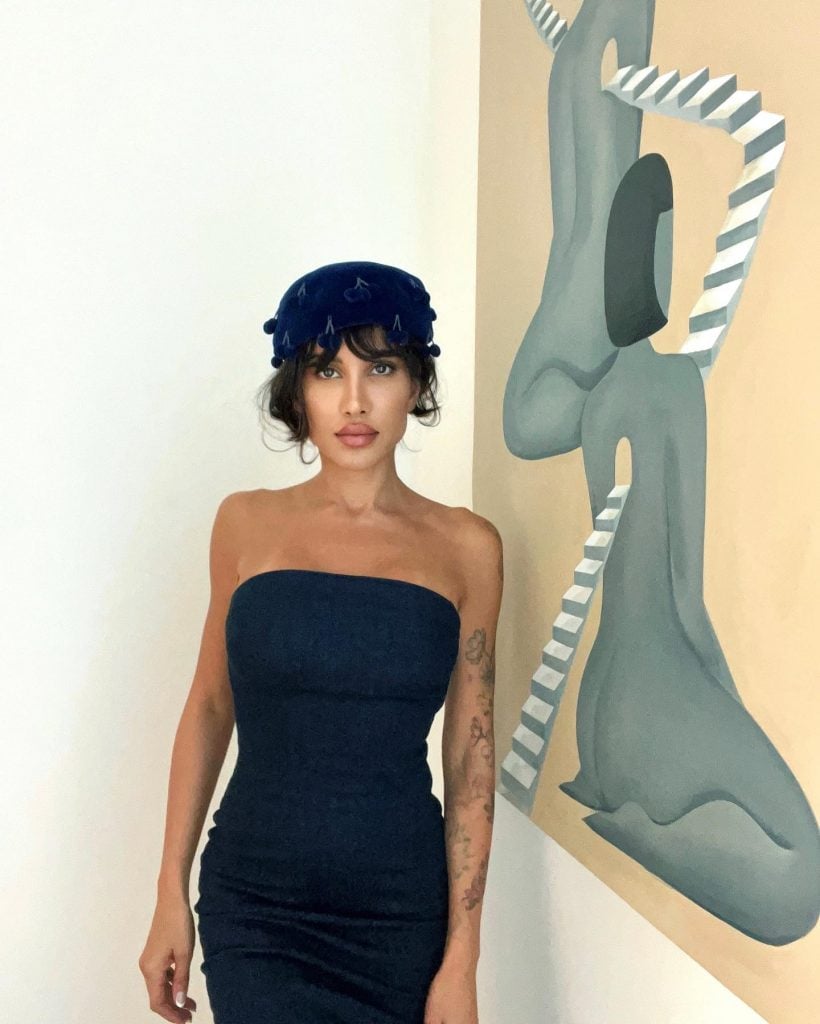
Mina Alikhani. Photo courtesy of Mina Alikhani
I’ve seen a lot of photographs from Iran in the 1960s, and it looks very different from photos today. Do you ever look at such images for inspiration or reference?
I have photographs from my family and, of course, the Internet. But my family worked for Shah Pahlavi before he was overthrown, so I have a lot of personal photos that I’ve looked at since I was a kid showing how European Iran felt. It was at the forefront of fashion and culture, and there were multiple religions thriving. Judaism was thriving within Iran. There’s a large Jewish Iranian population that left in 1979.
Amid current tensions in the Middle East, is there anything that you hope people learn from your work that can be applied to greater knowledge of the region?
Iran backs Hezbollah. It backs Hamas and the Houthis. People don’t understand that all of those are proxies of the Islamic Republic, first and foremost. But I first started this body of work prior to October 7. [The date Hamas attacked Israel, killing 1,200 people and taking 240 taken hostage. Since then, more than 35,000 have died in Israeli offensives in Gaza.] I’ve been working on this for a year and a half. Back then, I just had the intent that this work would educate about the gender apartheid and oppression in Iran and invite people to be curious about what the Islamic Republic is doing and how that affects all of us.
Now, I’m kind of seeing the world unfold and fall apart since October 7. The only way to save the people of the Middle East is to heal the heart of humanity here in the West and to inspire curiosity to understand the situation rather than to jump on some fake, woke bandwagon of fetishizing the struggle of people in other countries and the rah-rahing in the streets and universities.
After this show, where do you go next? What kinds of themes are you hoping to touch on?
I’ve already started working on my next series. And it’s going to be a further exploration into humanity and what motivates us, and how fragile and how delicate and how silly we are. The imagery does change, and it’s not so specifically politically focused. That’s kind of been my journey as an artist: I started very specifically and literally and am now zooming out to the bigger picture.